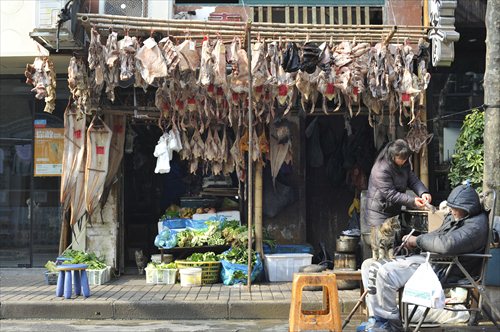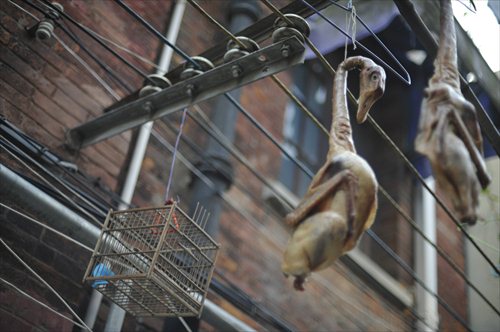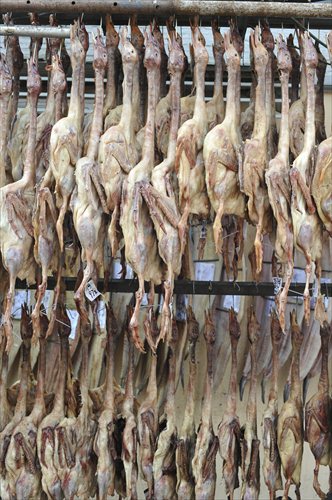‘Tis the season for air-dried meats and fish, a Shanghai winter specialty

An elderly lawei vendor plays with a cat in front of his store on Danshui Road. Photo: Tom Carter/GT

Moray eels with the papers of the names of the customers who bought them prior to the curing process Photo: Tom Carter/GT
Like cold cures, of which there are many in Traditional Chinese Medicine, at this time of year, cold-cured meats and fish are a common sight in Shanghai. One cannot pass through a residential community or shopping street in the winter without seeing mobiles of meats and strips of seafood strung up from windows, clothes hangers, electrical wires and even tree branches.
These are collectively known as lawei, a beloved South China specialty rooted in the tradition of slaughtering the family livestock to celebrate the Spring Festival. Non-locals often mistakenly refer to these as "waxed meat" not just because the curing fat feels waxy, but because la in Putonghua coincidentally means "wax" in addition to also meaning "winter month" and "cured meat."

Cold-cured fowl and a bird cage hang from wires in a traditional community near Huaihai Road. Photo: Tom Carter/GT

Pressed pig's head and other delicacies Photo: Tom Carter/GT

A rack of air-dried fish (fenggan yu) in front of a former Zhabei district apartment building Photo: Tom Carter/GT
Typically reserved for layue, the 12th month of the Chinese lunar calendar, lawei have over the centuries become a seasonal snack for city-dwelling Shanghainese who, lacking livestock, depend on vendors or countryside relatives for their holiday fare. Chicken, duck, pork, eel and fish are the preferred meats, along with the omnipresent lachang sausage - made of their innards so as to waste nothing - which hang like Christmas lights in homes leading up to Spring Festival feasts.
"Shanghai's soft winter sun lets the meat cure slowly, which gives our lawei a more unique flavor than the provinces with strong sunlight," said one vendor on Xiangyang Road South, whose storefront is at present barricaded by a great wall of dried ducks.

Strips of sausages (lachang) drying on clothes hangers Photo: Tom Carter/GT

A great wall of drying ducks at a shop on Xiangyang Road South Photo: Tom Carter/GT
As told by the vendor while hanging a man-sized moray eel, customers place their orders in advance and leave their purchases in the shop for the long curing process. Critters are gutted but otherwise left whole - beaks, claws, eyes and all - then heavily salted to draw out moisture and marinated for many days in huangjiu (yellow rice wine) or peppercorns before being hung up for three or four weeks of wind drying.
As salt and the frigid air discourage bacterial growth and allow the food to keep till summer, cold-curing is a time-tested process of naturally preserving perishables, even in space-aged Shanghai, which provides an ironic backdrop to this ancient tradition.
Newspaper headline: Cold-cured comforts